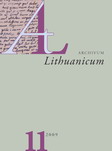Pirmųjų lietuvių kalbos gramatikų pėdsakai rankraštiniame žodyne Clavis Germanico-Lithvana
Traces of the first Lithuanian grammars in the manuscript dictionary Clavis Germanico-Lithvana
Author(s): Birutė TriškaitėSubject(s): Theoretical Linguistics, Historical Linguistics, Baltic Languages, 17th Century
Published by: Lietuvių Kalbos Institutas
Keywords: Germanico-Lithvana; manuscript dictionary; Lithuanian language and grammar; 17th century;
Summary/Abstract: The paper sets out to examine the relationship between the manuscript German-Lithuanian dictionary Clavis Germanico-Lithvana (the year 1680 is its terminus post quem; C) and the first Lithuanian grammars which appeared in Lithuania Minor (East Prussia): Daniel Klein’s Grammatica Litvanica in Latin (1653, KlG) and its summary in German Compendium Litvanico- Germanicum (1654, KlC) as well as Christophorus Sappu[h]n and Theophil Gottlieb Schultz’s Compendium Grammaticæ Lithvanicæ (1673, SŠG). A comparative-textological analysis has helped to show that the compiler of Clavis was referring to all three grammars (KlG, KlC, SŠG), though to a different extent: the dictionary mainly draws on KlG; references to the other two (KlC and SŠG) are scarce. Actual references to the grammars found in the dictionary are much more numerous than explicitly acknowledged. Both explicit and actual references to Klein’s grammars have been found in two chronological layers of Clavis: in the main text and amendments handwritten by the compiler himself. Klein’s two grammars (KlG and KlC) were mainly made use of when amending the dictionary. References to SŠG were found in dictionary amendments; so the grammar was used as reference during later stages of compiling the dictionary. The character of referencing to the first Lithuanian grammars by the compiler of Clavis is varied. From KlG and KlC the compiler collected Lithuanian (sometimes also Latin and German) illustrative examples, much less often he made use of the grammatical information on Lithuanian words (usually focusing on their syntactic combinability, basic and derived forms) and also transcribed one or another Lithuanian equivalent. From SŠG the compiler transferred to his dictionary some grammatical information and Lithuanian equivalents. The first Lithuanian grammars were used merely as additional sources by the compiler of Clavis; however, they seemed to be of great importance and served as the basis for expanding the dictionary entries. Due to its developed microstructure, the dictionary can be treated as excelling other manuscript German-Lithuanian dictionaries of that time which were prepared in Lithuania Minor.
Journal: Archivum Lithuanicum
- Issue Year: 2009
- Issue No: 11
- Page Range: 63-120
- Page Count: 58
- Language: Lithuanian

